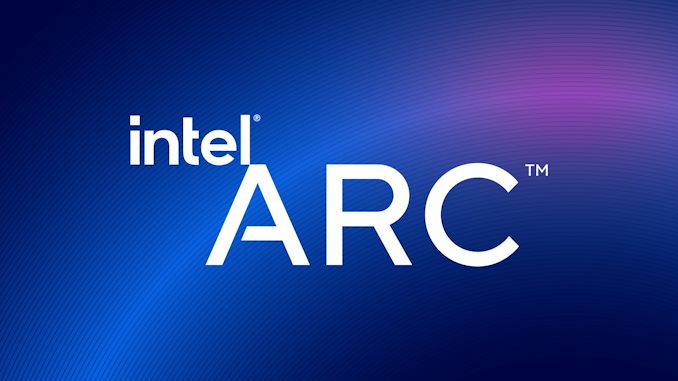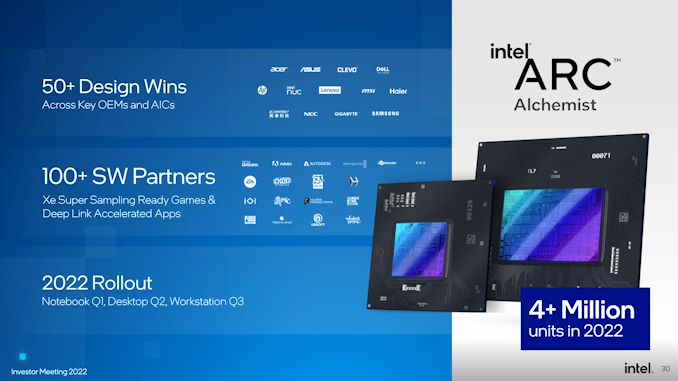Intel Arc Update: Alchemist Laptops Q1, Desktops Q2; 4mil GPUs Total for 2022
by Ryan Smith on February 17, 2022 11:45 AM EST
As part of Intel’s annual investor meeting taking place today, Raja Koduri, Intel’s SVP and GM of the Accelerated Computing Systems and Graphics (AXG) Group delivered an update to investors on the state of Intel’s GPU and accelerator group, including some fresh news on the state of Intel’s first generation of Arc graphics products. Among other things, the GPU frontman confirmed that while Intel will indeed ship the first Arc mobile products in the current quarter, desktop products will not come until Q2. Meanwhile, in the first disclosure of chip volumes, Intel is now projecting that they’ll ship 4mil+ Arc GPUs this year.
In terms of timing, today’s disclosure confirms some earlier suspicions that developed following Intel’s CES 2022 presentation: that the company would get its mobile Arc products out before their desktop products. Desktop products will now follow in the second quarter of this year, a couple of months behind the mobile parts. And finally, workstation products, which Intel has previously hinted at, are on their way and will land in Q3.
The pre-recorded presentation from Koduri does not offer any further details as to why Intel has their much-awaited Arc Alchemist architecture-based desktop products trailing their mobile products by a quarter. We know from previous announcements that the Alchemist family is comprised of two GPUs, so it may be that Intel is farther ahead on manufacturing and delivering the smaller of the two GPUs, which would be best suited for laptops. Alternatively, the company may be opting to focus on laptops first since it would allow them to start with OEM devices, and then expand into the more complex add-in board market a bit later. In any case, it’s a notable departure from the traditional top-to-bottom, desktop-then-laptop style launches that current GPU titans NVIDIA and AMD have favored. And this means that eager enthusiasts looking for an apples-to-apples look at how Intel’s first high-end GPU architecture fares, we’re going to be waiting a bit longer than initially expected.
Meanwhile, between mobile, desktop, and workstation products, Intel is expecting to ship over 4 million units/GPUs for 2022. To put this in some kind of reference, Jon Peddie Research estimates that the GPU AIB industry shipped 12.7 million boards in Q3’21. Which, pending Q4 numbers being released, would have put the industry as having shipped over 40 million discrete boards altogether over 2021. And while this is a bit of an apples-to-oranges comparison since Intel is counting both AIB desktop and mobile products, it does underscore the overall low volume of Alchemist chips that Intel is expecting to sell this year. Assuming AMD and NVIDIA deliver as many chips in 2022 as they did in 2021, Intel will be adding at most no more than another 10% to the overall volume of GPUs sold.
On the whole, this isn’t too surprising given both current manufacturing constraints and Intel’s newcomer status. The company is using TSMC’s N6 process to fab their Alchemist GPUs, and TSMC remains capacity constrained during the current chip crunch; so how many wafers Intel could hope to get was always going to be limited. Meanwhile as a relative newcomer to the discrete GPU space – a market that has been an NVIDIA/AMD duopoly for most of the past two decades – Intel doesn’t have the customer inertia that comes from offering decades of products. So even if Alchemist products perform very well relative to the competition, the company still needs time to grow into AMD and NVIDIA-sized shoes and to woo over the relatively conservative OEM base.
Celestial Architecture Under Development: Targeting Ultra Enthusiast Market
Along with the update on Alchemist, Koduri’s presentation also offered a very (very) brief update on Celestial, Intel’s third Arc architecture. Celestial is now under development, and at this point, Intel is expecting it to be their first product to address the ultra-enthusiast market (i.e. the performance crown). GPUs based on the Celestial architecture are expected in the “2024+” timeframe; which is to say that at this far out Intel doesn’t seem to know for sure if they’ll be 2024 or 2025 products.
Covering the gap between Alchemist and Celestial will be Battlemage, the second of Intel’s Arc GPU architectures. Battlemage now has a 2023-2024 release date, with Intel expecting the architecture to improve performance over Alchemist to the point where Battlemage will be competitive in the enthusiast GPU market – but not quite reaching the ultra-enthusiasts that Celestial will.
Finally, by virtue of this disclosure, it would seem that Battlemage will be the first Arc GPU architecture to make it into Intel’s CPUs. The company has it slated to be implemented as a tile on Meteor Lake CPUs, making this the crossover point where Intel’s current Xe-LP GPU architecture finally gets retired in favor of a newer GPU architecture.
Source: Intel












13 Comments
View All Comments
plopke - Thursday, February 17, 2022 - link
"Meanwhile, between mobile, desktop, and workstation products, Intel is expecting to ship over 4 million" So if I understand this correctly , if you subtract like OEM(laptop/desktop/workstation) , wouldn't this mean like AIB Intel GPU's to like almost nothing?Achaios - Thursday, February 17, 2022 - link
In the beginning they implied "ARC GPUs rdy by Q4 2021" then they went to early Q1 2022 now it's "not rdy until (end of ) Q2 2022".Summer 2022 for desktop GPUs at the earliest, Fall or Winter 2022 more likely IMO.
Matthias B V - Thursday, February 17, 2022 - link
Yeah I was also hoping for DG2 in Q4/2021 as then we could see a quick follow up of DG3 in Q4/2022 and DG4 in Q4/2023 to H1/2024... Especially since originally DG2 was expected for H2/2021 with some hoping for Q3/2021...Intel has to catch up so a fast cadence is expected. Also there should be a lots of low hanging fruits. With DG3 we already should see significant increases as most bugs are fixed and they might move to TSMC N4 and maybe already go for chiplets... By DG4 I would say intel managed chiplet GPU designs as well as drivers and node so they could really go head to head with AMD and Nvidia.
But I guess since DG2 is deayed and Corona reminded us how fast things can change they also became more careful with roadmaps...
Matthias B V - Thursday, February 17, 2022 - link
I would hope we see MeteorLake Mobile by Q4/2022 or Q1/2023 parallel to RaptorLake Mobile while keep desktop mainly on RaptorLake. They did same with IceLake and CometLake...Especially on mobile the new node and packaging combined with updated arch should provide significant advantages. And against Zen4 on TSMC5 this would be well needed...
By late 2023 we could see ArrowLake as successor for the whole lineup from Desktop to Mobile. Intel 4 / 3 should be mature by then as well as their chiplet and packaging technologies. And again this is also needed if AMD brings a big+little Zen5 on TSMC N3...
JimRamK - Wednesday, March 30, 2022 - link
Thats way too optimistic for Meteor Lake. I don't think it's coming before Q2 2023 if not later.dwillmore - Thursday, February 17, 2022 - link
Interesting how Intel and TSMC are interacting here. Intel never used to fab for anyone else and scoffed at the market. Then they aquired a few companies which did fab for external partners and they remained a second class citizen. With the continued growth of TSMC, Intel is seeing fabing for external partners as more and more of a future revenue system. That's fine.But, what I find interesting is how Intel is buying up TSMC capacity (legitimently because they don't currently have the capacity for some of thier parts) while they ramp up their own fabs. But what's the next step? After Intel elbows out TSMCs clients--while they ramped up fab capacity--they leave TSMC with excess fab capacity. All the while Intel has been siphoning off clients from the fab starved TSMC. Now we live in a world with excess capacity and is that a battle TSMC can win against Intel?
Templewolf - Friday, March 4, 2022 - link
Intel is funding TSMC to improve their manufacturing process and get even further ahead of intel. If anything you have ask if Intel can acheive the scale to match TSMC or even Samsung.jamesindevon - Thursday, February 17, 2022 - link
Not in the least bit surprised that they're going for laptops first.For one thing, they have existing relationships with the laptop manufacturers to leverage, shall we say, in the same way as Intel persuaded the manufacturers to sell laptops with spinning rust and ~16 GB of Optane memory. For another, the contracts that will be in place mean Intel already have a good idea how many chips they can sell (imagine if they started with desktop boards and the community decided they were trash: how embarrassing not to be able to sell GPUs in the current market!)
Also, it's two decades since we've had a proper low-end competitor in the graphics market. Many of the influencers and reviewers who are going to pronounce judgment on Arc will be of the mindset that if it doesn't compete with Nvidia's most expensive card, and work as well as them, it's pointless.
Releasing into the laptop market first means, at least, that the initial Arc offering will be compared with laptop GPUs.
Finally, the desktop market would almost entirely be gamers. There seems to be room in the market for all-round laptops where discrete graphics are nice to have, but users spend less time gaming (and are much less hard-core gamers) so are less likely to be so critical of issues with particular games.
RSAUser - Wednesday, March 2, 2022 - link
Another argument is power scaling. Intel's chips probably do well in the 50-100W range with diminishing returns, Nvidia got the 3k series to be "fast" by upping the power, performance per watt hasn't improved between 2k and 3k. Used to be the 1k series laptop/desktop equivalent were pretty close (finally), but you can't put a 250W part in a laptop.im.thatoneguy - Thursday, February 17, 2022 - link
"it’s a notable departure from the traditional top-to-bottom, desktop-then-laptop style launches that current GPU titans NVIDIA and AMD have favored."I don't find this surprising at all. Intel is already shipping GPUs in the mobile space. They already have customers lined up to buy their latest and best mobile GPU. An Intel Arc mobile customer is already an Intel Xe mobile customer.
Releasing mobile first also gives them a differentiating opportunity. While Nvidia is going to win for top performer without question, the mobile space isn't as competitive or clearly dominated. Intel stands a chance of being the "fastest mobile GPU'. A crown they stand no chance to take in the desktop space right now.